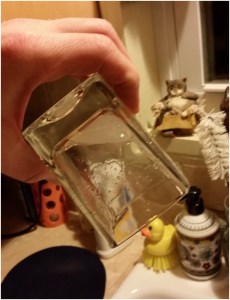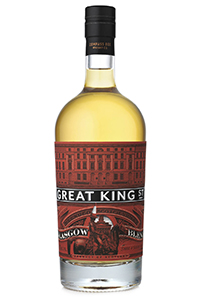Whiskey Wedge
From time to time we also get requests to take a look at whiskey related books and products in addition to the actual whiskey. Gary was kind enough to take a stab the The Whiskey Wedge by Corkcile which retails for about $17.95 (and is also available on Amazon). Here are his thoughts…
Writing reviews of whiskey is still new territory, although the format is fairly standard (while there are variations, nearly all of us comment on the nose, taste, and finish). How to write a review of a whiskey tool was a challenge. I started with what questions I would want to answer. My list started with these:
- How much would the Whiskey Wedge cool my whiskey?
- Would whiskey get around the edges of the cube right away, causing it to break away prematurely and become an “obstacle” to pleasant drinking?
- How long would it take before the ice would break away from the glass, and how large would the remaining cube be at that time?
- What might surprise me along the way that I hadn’t thought of initially?
With those in mind, I started to play with the Whiskey Wedge. After opening the package, I washed the glass and mold – twice. The mold still had a chemical odor, though as long as it doesn’t impart this on the ice (and my whiskey!), it isn’t a big deal (spoiler: it didn’t). After filling the glass per the instructions, it looked like some water may have worked its way around the mold, although it would be a very small amount. Filling right to the fill line is tricky, since the area you are filling is getting smaller and smaller. Twice I over filled, and had to tip the glass on its side to remove some of the water. I’m not sure if having it a bit above the fill line would do any harm, but wanted to follow their instructions as best I could.
Despite this effort, the ice barely came out of the top.
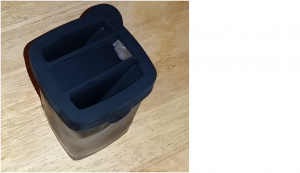
This made removing the mold a bit of a struggle, but not too bad. I realized that I didn’t know how much the glass would hold – so I started with 2 oz of Stagg Jr. bourbon (134.4 proof, 67-68 degrees F). This left a fair amount of room in the glass, so I added another 2 oz which still left about a ½ inch of room from the lip of the glass.
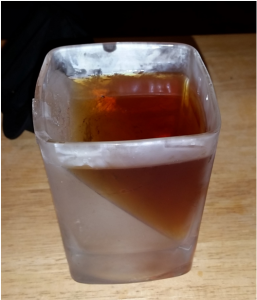
For me, 4 oz is a major pour, and likely my only one of the night. After just under 2 minutes, I tested the temperature of the whiskey, and it had already dropped to 48 degrees. While it had cooled quickly, my first couple of sips stilled seemed quite stiff. I noticed that as the ice was melting, the water seemed to be settling at the bottom of the glass, to where the “point” was perfectly clear. I wanted to mix it up a bit, but simply giving the glass a casual turn was not effective. I used my thermometer as a stirrer, which mixed the water and whiskey nicely.
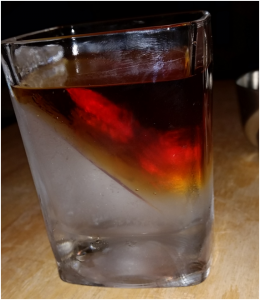
After 15 minutes, the whiskey was a cool 34 degrees – much colder than other tools I had used (although to be fair, I hadn’t employed a frozen glass with those!). After stirring, the dilution you expect from some ice was working much better – so I definitely recommend employing a stir stick. I sipped the drink for an hour, not coming close to finishing it. At that point, the whiskey had only warmed to 38 degrees – still plenty cold, and syrupy sweet.
Feeling satisfied, I revisited my initial questions.
- How much would the Whiskey Wedge cool my whiskey?
- Quite a bit! From 68 degrees to 34 degrees in 15 minutes, and held it below 40 degrees even an hour later. I was very pleased on this front!
- Would whiskey get around the edges of the cube right away, causing it to break away prematurely and become an “obstacle” to pleasant drinking?
- Another score. I approached this with healthy skeptisicism, and while I certainly wasn’t rooting for failure, I kinda thought it would break off the bottom sooner than I wanted it to. Hell, I even set the glass on the table with some force after 45 minutes, and it never budged. In fact, after one hour, I dumped the remaining whiskey in another glass, and held the Whiskey Wedge upside down over my sink . . . and the cube still stuck like glue to the glass. Again – flying colors in my book.

- Another score. I approached this with healthy skeptisicism, and while I certainly wasn’t rooting for failure, I kinda thought it would break off the bottom sooner than I wanted it to. Hell, I even set the glass on the table with some force after 45 minutes, and it never budged. In fact, after one hour, I dumped the remaining whiskey in another glass, and held the Whiskey Wedge upside down over my sink . . . and the cube still stuck like glue to the glass. Again – flying colors in my book.
- How long would it take before the ice would break away from the glass, and how large would the remaining cube be at that time?
- If it would have happened, it would have been more than an hour later – and the cube at one hour was a pretty manageable size (I’d say it was between ¼ and 1/3 the size of the original cube).
- What might surprise me along the way that I hadn’t thought of initially?
- The bit about needing a stirrer is something I hadn’t anticipated. I’m used to just holding the top of my glass and rotating it a bit to mix things up, but that wasn’t very effective given that the cube is stationary.
All in all, if you are looking to chill your whiskey without diluting it too quickly (but still diluting it over time), I have no reservations recommending the Whiskey Wedge (although I would also recommend having a stirrer on hand).
Thanks to Kim Miller at Corkcicle for providing the sample!
– Gary


